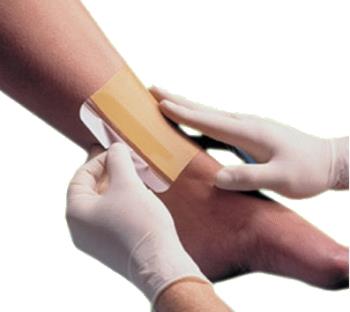
Decubitus ulcers or pressure sores/bedsores can be a serious problem for patients that are immobile. They are caused by pressure on soft tissue over bony areas of the body. Areas such as the coccyx, heels, hips, and other joints are susceptible to this type of pressure wound. These ulcers can lead to complications such as autonomic dysreflexia, infection, and can be life-threatening. The best way to cure them is to actually prevent them. For example, an air mattress for a bed is great for sleeping, or patients in a wheelchair can use an air-filled pad (such as a Roho pad).
Even with the most diligent care, an ulcer can develop. Once these wounds develop, it is important for them to heal as soon as possible to avoid infection and other complications. There are numerous types of dressings that can help with this.
Hydrocolloid dressings use a gel type agent to promote healing. It’s been proven that a moist wound heals faster than a dry wound. In the presence of wound exudates, these hydrocolloid dressings absorb the liquid and form a gel. These dressings can be impermeable to water vapor, but as the gelling process takes place the dressing becomes progressively more permeable. One of the benefits of this type of dressings is that they can adhere to moist areas as well as dry wounds. Hydrocolloid dressings are easy to use, require changing every 3-5 days, and don’t cause trauma to the wound. Some types of hydrocolloid dressings are Tegaderm, Duoderm, and Granuflex among others.

Foam dressings are highly absorbent dressings made predominately from hydrophilic polyurethane foam. These dressings can have various absorption rates, varying by brand. Some foam dressings have a centerpiece of foam surrounded by adhesive so that the dressing can remain in place without slipping. With the varying rates of absorption, a more absorbent dressing can remain in place longer. This can reduce the rate at which a caregiver needs to replace the dressing. This type of dressing is good for heavily exudating wounds, especially during the inflammatory period when drainage is at its peak. The benefit of this type of dressing is they are comfortable and conformable.
Alginate dressings are highly absorbent dressings made from seaweed. These dressings maintain a moist environment to promote healing. Alginate can be rinsed away with a saline solution so removal does not interfere with the healing process. This, in turn, makes dressing changes virtually painless. This type of dressing would be a good choice for ulcers that are exuding a lot of liquid. Some alginate dressings on the market are Aquacel, Maxorb, and Kaltostat.
Hydrofiber dressings are a relatively new concept in the field of the wound dressing. Since they can be worn for several days at a time, they can be a very cost-effective option. They work by gelling upon contact with moisture, locking in moisture that is absorbed by the dressing. They maintain a healthy moisture balance so that a wound is not too wet or too dry. This type of dressing provides a passive 7method of wound control that fills spaces where bacteria can thrive. With the addition of a silver cream, an antimicrobial environment can be established for infected wounds. The main ingredient in this type of dressing is sodium carboxymethylcellulose. These dressings come in a sterile, soft nonwoven pad or as a ribbon dressing for convenience.
Contact layer dressings that are coated with silicone are highly comfortable and gentle in adhesion. Versatel and Versatel One Contact Layer Dressings are thin, flexible, and conform to the shape of the wound. Versatel Silicone Coated Dressings can be placed on a wound easily while preventing scissors, gloves, other agents from sticking to the dressing. Versatel helps keep the secondary dressing in place as it is two-sided. It prevents a patient with decubitus ulcer from pain and infections by not sticking to moist wound beds, thereby minimizes peri-wound maceration. You can observe the wound recovery progress without disrupting periwound skin through its translucent material. The porous structure allows fluid transfer to secondary dressing and helps in topical medication.
What are the signs of a decubitus ulcer?
Each stage of a decubitus ulcer has various symptoms. Depending on the stage of Decubitus Ulcer, you may have any of the following:
Stages of Decubitus Ulcers
The stages of a decubitus ulcer are as follows: Decubitus ulcers are divided into stages. Your healthcare professional will use a staging system to diagnose and treat you.
Stage 1: The skin isn't broken, but it is discolored. It may also be swollen and warm.
Stage 2: The skin breaks down, revealing a superficial ulcer or erosion. There can also be a fluid-filled blister.
Stage 3:The ulcer is much deeper inside the skin, and it affects your fat layer and looks like a crater.
Stage 4: At this stage, many layers are affected, including your muscle and bone.
Where can I buy Decubitus Ulcers treatment Dressings?
Shop Woundcare has a wide range of effective and pocket-friendly solutions to treat Decubitus Ulcers. Buy from top leading manufacturers and get the best online shopping deals on every purchase you make. Order Today!
Disclaimer: All content found on our website, including images, videos, infographics and text were created solely for informational purposes. Our content should never be used for the purpose of diagnosis or treatment of any medical conditions. Content shared on our websites is not meant to be used as a substitute for advice from a certified medical professional. Reliance on the information provided on our website as a basis for patient treatment is solely at your own risk. We urge all our customers to always consult a physician or a certified medical professional before trying or using a new medical product.